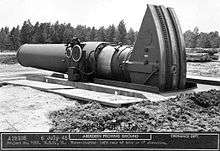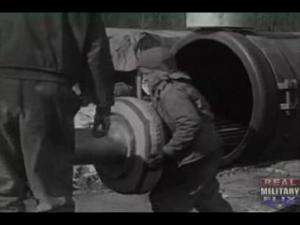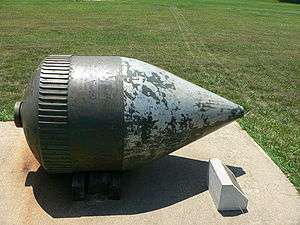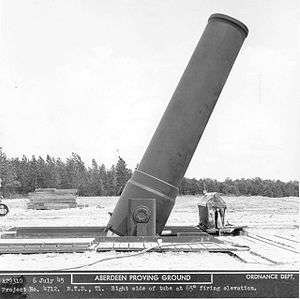Little David
| Little David | |
|---|---|
|
Little David at the Aberdeen Proving Ground | |
| Type | Heavy mortar |
| Place of origin | United States |
| Service history | |
| In service | Testing only |
| Used by | United States |
| Wars | World War II |
| Specifications | |
| Weight | 40 tons (without carriage) |
| Barrel length | 22 feet (6.7 m) |
|
| |
| Shell | 3,650 pounds (1,656 kg) |
| Caliber | 36 inches (914 mm) |
| Barrels | 1 |
| Muzzle velocity | 1250 ft/s (381 m/s) |
| Maximum firing range | 6 miles (9.7 km) |
| Feed system | Muzzle loading |
Little David was the nickname of an American 36-inch (910 mm) caliber mortar used for test firing aerial bombs during World War II, that is one of the largest calibre guns ever built, having a larger calibre than both of Germany's Dora and Gustav which were 31.5-inch (800 mm) railway guns.[1]
History
The mortar was originally used as the launching mechanism for test-firing aerial bombs at Aberdeen Proving Ground (during the war, bombs became larger and larger, necessitating the construction of such a large calibre gun). Little David was therefore not intended as a combat weapon. The mortar's base was a large steel box that was placed below ground, with its top flush with the surrounding surface, allowing the mortar's muzzle to be lowered horizontal for loading at ground level.[1]

By 1944, it was expected that American forces would encounter extremely strong fortifications during the expected invasion of Japan. Studies began on using Little David as a siege mortar. The mortar was converted into a two piece mobile unit, consisting of the 80,000-pound (36,000 kg) barrel and the 93,000-pound (42,000 kg) base transported by two artillery tractors. In addition to the two main loads, the Little David unit would also include a bulldozer and crane with bucket to dig the emplacement for the mortar's base.[2]
The huge mortar could be ready to fire in 12 hours. The largest (800 mm) known German artillery weapons were hauled on 25 railway cars and required three weeks to put in firing position.[2]
Little David was one of the largest artillery pieces ever produced by calibre, although Dora fired a heavier shell. Little David's overall effectiveness would have been questionable because of its limited range and accuracy. When Japan surrendered, the invasion became unnecessary, and Little David (still in its trial phase) never saw combat.
Little David currently resides in the outdoor collection of armor and artillery pieces at the Aberdeen Proving Ground in Maryland.


See also
References
Notes
- 1 2 "The Militaryfactory web site". www.militaryfactory.com. retrieved 2 February 2013
- 1 2 "Little David at Global Security". www.globalsecurity.org. Retrieved 14 February 2012
External links
| Wikimedia Commons has media related to Little David mortar. |
- globalsecurity.org - 36-inch Little David
- Little David Mortar Present day photos of the Little David Mortar at Aberdeen Proving Grounds, MD
